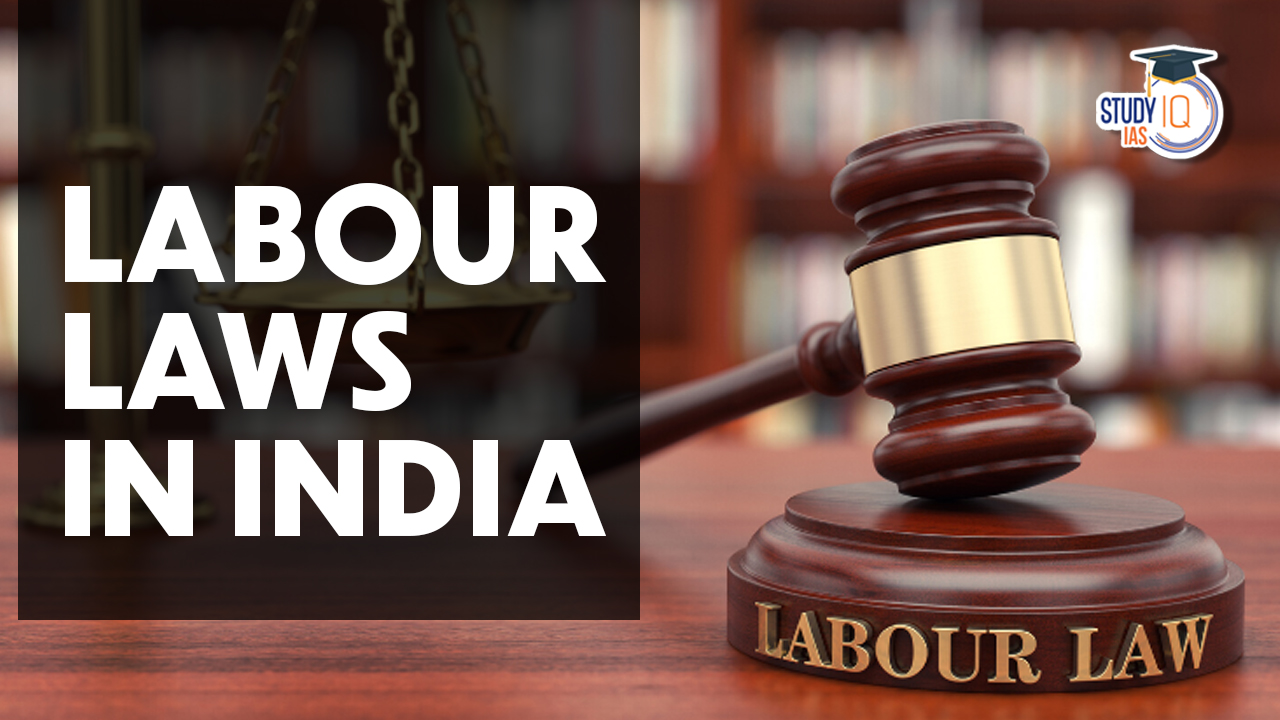Table of Contents
Labour Laws in India
Due to the fact that it did not match the record employment growth, India’s growth story has remained unfinished. Although there was a slowdown in employment from 2000 to 2009, the Indian economy expanded on average by 8%. In spite of the numerous labour regulations in India, they only protect 7–8% of the employed employees in the organised sector, at the expense of 93% of those employed in the unorganised sector.
Labour Laws in India Overview
India’s labour regulations have been under consideration for the past few years. The Seventh Schedule’s concurrent list includes the subject of labour, allowing both the Centre and the States to pass laws addressing labor-related concerns. There are currently 44 labour laws under the control of the federal government and over 100 under state control, covering a wide range of labor-related topics.
|
Labour Laws in India Overview |
|
| Particulars | Details |
| Constitutional Provisions |
Article 39, 39A, 41, 42, 43 and 43A of the Constitution can collectively be termed “Magna Carta for the working class in India.”
|
| Commission recommended Labour Codes | The Second Labour Commission 2002 recommended on grouping the central labour laws into – Industrial Relations, Wages, Social Security, Safety, Welfare and Working Condition. |
| 4 Labour Codes | Indian Parliament approved the 4 Labour Codes in 2020 for the integration of 29 set of Labour Laws:
|
Labour Codes
The Parliament authorised 4 labour codes in 2020 to replace 29 sets of employment regulations and incorporate these many statutes. All four labour laws have previously received the President’s blessing and approval from the Parliament.
Code on Wages 2019
It seeks to increase the legal protection of the minimum wage and guarantees every worker their “Right to Sustenance,” universalizes the requirements for minimum wages and quick payment of payments regardless of the industry or wage ceiling.
- It subsumed 4 central legislations as – Minimum wages Act 1948, Payment of Bonus Act 1965, Equal Remuneration Act 1976 and Payment of Wages Act 1936.
- The federal government will determine the floor wage while taking into account workers’ living conditions.
- Setting the minimum wage: The federal or state governments will set the minimum wages, which must be higher than the floor wage, and will review and revise them every five years at the most.
- Employees who work beyond the typical working day are entitled to overtime pay, which must be at least double the regular rate of pay.
- Bonus amount: All employees will be entitled to a yearly bonus that will be at least 8.33% of their earnings or Rs 100, whichever is larger, if their salaries do not exceed a particular monthly sum that has been announced by the federal or state governments. An employee is only eligible to collect bonuses up to 20% of his annual salary.
- Discrimination based on gender is prohibited in areas involving pay and hiring workers for similar or identical jobs.
Code on Industrial Relation 2020
- Employers of industrial facilities with 100 or more employees are required to outline the terms of employment and expectations for behaviour under the Industrial Employment (Standing Orders) Act of 1946.
- The new standing order requirement applies to all industrial businesses with 300 or more employees who were either employed today or on any day during the previous calendar year.
- It also includes new specifications for carrying out a legal strike. The requirements for workers before engaging in a valid strike now include the timeline for arbitration procedures as well as the period for conciliation.
- A fund for retraining laid-off workers has also been proposed, with funding provided by the company equal to the 15th day of their most recent payment.
Code on Occupational Safety, Health, and Working Conditions Code Bill, 2020
- According to the criterion, interstate migrant workers independently go from one state to another to find employment, making up to Rs. 18,000 per month.
- The proposed idea makes a distinction between regular employment and just contractual employment.
- A journey allowance, or one-time payment of transport costs to be given by the employer for an employee’s travel to and from their place of employment, has been proposed in place of the former provision for temporary lodging for employees near to the workplaces.
Code on Social Security Code Bill, 2020
- It recommends setting up a National Social Security Board to advise the federal government on developing suitable policies for different categories of unorganised employees, gig workers, and platform workers.
- Aggregators that use gig workers must also contribute between 1% and 2% of their annual earnings, up to a maximum of 5% of the total amount paid by the aggregator to gig and platform workers, towards social security.
Benefits of Labour Codes
The benefits of the four-labour code have been given below:
- It is anticipated that litigation will decline as a result of the 2019 Code of Wage Act, which simplifies the idea of pay. This will ensure that every worker receives a minimum salary and improve their purchasing power, both of which will spur economic growth.
- The three Codes (IR, SS, and OSHW) streamline the labour laws by consolidating 25 central labour legislation that have been on the books for at least 17 years.
- Despite a reduction in the number of definitions and authorities that apply to businesses, it will result in a considerable rise in employment and industry.
- The codes specify only one licencing process.
- The guidelines also streamline out-of-date laws governing workplace disputes and modernise the adjudication process, promoting early conflict resolution.
- Industry insiders and some economists anticipate that this legislation will boost investment and streamline business dealings. It greatly reduces internal complexity and inconsistencies, increases adaptability, and modernises rules.
- In any industry, women must be permitted to work at night, but only if the employer has taken steps to assure their protection and only after receiving their consent.
- Maternity leave now lasts for 26 weeks instead of the previous 12 weeks. Women are now able to work in mines because to the Pradhan Mantri Rojgar Protsahan Yojana (PMRPY).
Labour Code UPSC
The labour regulations may be considered “historic” because they have been around for almost a century, but the Union government exaggerated their significance by calling them “landmark” and “game-changer” laws. In the greater interest of our country, every law must strive to maintain the best possible balance between conflicting interests and should make every effort to provide the weaker of the two sides with as much support as they are capable of receiving.


 Repo Rate and Reverse Repo Rate, Impact ...
Repo Rate and Reverse Repo Rate, Impact ...
 Foreign Contribution Regulation Act (FCR...
Foreign Contribution Regulation Act (FCR...
 Urban Cooperative Banks in India, Functi...
Urban Cooperative Banks in India, Functi...





















